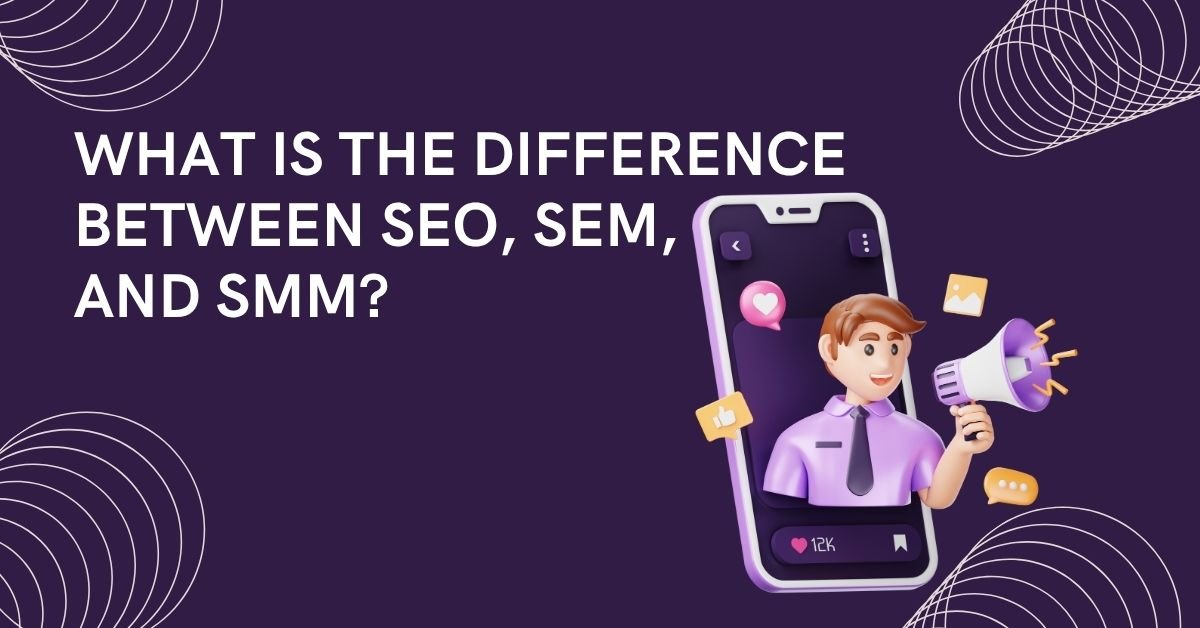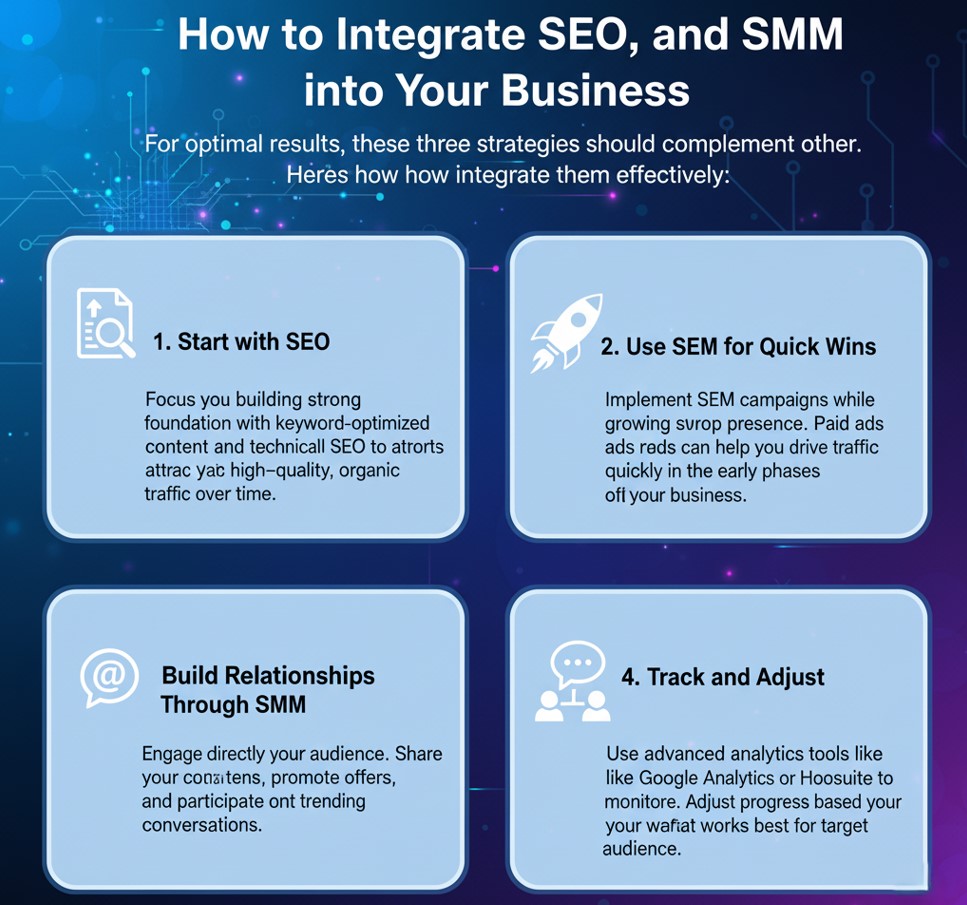
If you’ve been exploring digital marketing strategies, you’ve likely come across the terms SEO, SEM, and SMM. For many businesses, understanding the difference between these acronyms can be the key to crafting a winning online strategy. But what do they all mean, and more importantly, how can you make them work for your goals?
This post breaks down SEO (Search Engine Optimization), SEM (Search Engine Marketing), and SMM (Social Media Marketing) to help you understand their unique roles in your marketing strategy. By the end of this article, you’ll know how to integrate them effectively to capture attention, drive traffic, and boost engagement.
What Is SEO (Search Engine Optimization)?
SEO, or Search Engine Optimization, is the practice of optimizing your website and content to rank higher on search engine results pages (SERPs) organically. The goal is simple yet powerful—to make it easier for potential customers to find your site without relying on paid ads.
The Components of SEO
There are three primary components of SEO:
- On-Page SEO:
This involves optimizing elements directly on your website, including:
-
- Keywords and phrases
- Engaging meta titles and descriptions
- Header tags
- Image alt text
- Internal linking structure
Example: If you’re a bakery in New York, optimizing your website around a keyword like “best New York bakery” can help locals find you.
- Off-Page SEO:
Off-site efforts that build your website’s authority through:
-
- Backlink building (earning links from other trusted websites)
- Encouraging brand mentions organically
- Social sharing and engagement
- Technical SEO:
This focuses on the backend of your website to improve performance, including:
-
- Fast loading times
- Mobile responsiveness
- Crawl errors and fixing broken links
- Creating XML sitemaps for search engine crawlers
Advantages of SEO
- Cost-effective (no ad spend)
- Builds long-term credibility
- Drives high-quality, organic traffic
SEO takes time to show results, but its long-term benefits often outweigh the wait. This makes it a fundamental strategy for businesses looking to establish an enduring online presence.
What Is SEM (Search Engine Marketing)?
SEM stands for Search Engine Marketing and primarily focuses on paid strategies to increase visibility on search engines like Google. While SEO focuses on organic traffic, SEM gives you the ability to pay for placement in SERPs.
Key Elements of SEM
- Pay-Per-Click (PPC) Advertising:
The most common SEM strategy, PPC ads appear at the top of search results and only charge you when users click on them.
Example platforms:
-
- Google Ads
- Bing Ads
- Keyword Targeting:
SEM allows you to strategically bid on keywords relevant to your business. For example, an online shoe retailer might bid on “buy running shoes online.”
- Ad Copy and Extensions:
SEM campaigns also involve crafting compelling ad copy and adding extensions to highlight special offers or contact details.
Advantages of SEM
- Immediate visibility through paid promotion
- Results that are data-driven and customizable
- The flexibility to target specific demographics or geographic locations
While SEM costs can quickly add up, especially for competitive keywords, it’s a highly effective way to generate leads quickly. Pairing it with SEO can provide a balanced approach.
What Is SMM (Social Media Marketing)?
SMM refers to Social Media Marketing, which involves promoting your business on platforms like Facebook, Instagram, Twitter, LinkedIn, and TikTok. The focus is on building brand awareness and engaging directly with your audience.
Types of SMM
- Organic SMM:
-
- Consistent posting of relevant content
- Responding to audience comments or messages
- Building communities through Facebook Groups, LinkedIn networks, etc.
- Paid SMM:
- Ads promoting products/services
- Boosted posts to increase their reach
- Retargeting campaigns for users who interacted with your brand
- Influencer Marketing:
Collaborating with influencers who align with your branding to amplify content and expand reach.
Advantages of SMM
- Fosters quick engagement and two-way communication
- Creates user-generated content campaigns
- Strengthens brand loyalty and community building
SMM works best when paired with creative campaigns that resonate with your target audience, leveraging platforms they already use.
Comparing SEO, SEM, and SMM
It’s easy to get confused between SEO, SEM, and SMM because they often overlap. However, they serve different goals and shine in different scenarios:
|
Factor |
SEO |
SEM |
SMM |
|---|---|---|---|
|
Focus Area |
Organic search ranking |
Paid search advertising |
Social media platforms |
|
Goal |
Long-term traffic growth |
Immediate visibility/traffic |
Audience engagement & brand loyalty |
|
Cost |
Free (requires effort/time) |
Paid (flexible budget) |
Free + Paid Options |
|
Time to Results |
Slow (months to years) |
Fast (instant results) |
Varies (depends on activity) |
|
Measurement |
Organic traffic & ranking |
Conversion rates & ROI |
Social engagement metrics |
How to Integrate SEO, SEM, and SMM into Your Business

For optimal results, these three strategies should complement each other. Here’s how to integrate them effectively:
1. Start with SEO
Focus on building a strong foundation with keyword-optimized content and a technically sound website. Use your SEO efforts to attract high-quality, organic traffic over time.
2. Use SEM for Quick Wins
Implement SEM campaigns while growing your SEO presence. Paid ads can help you drive traffic quickly in the early phases of your business.
3. Build Relationships Through SMM
Engage directly with your audience on social media. Share your content, promote offers, and participate in trending conversations.
4. Track and Adjust
Use advanced analytics tools like Google Analytics, SEMrush, or Hootsuite to monitor your progress. Adjust your strategies based on what works best for your target audience.
When to Use Each Strategy
- SEO is essential for businesses aiming for long-term traffic and cost-effective growth.
- SEM is ideal for launching new products, limited-time offers, or entering competitive markets.
- SMM works best for businesses focusing on brand loyalty, audience engagement, and community building.
Each strategy has its strengths, and by leveraging them together, you can maximize your online reach.
Make Your Strategies Work Smarter
By now, you should have a clearer understanding of SEO, SEM, and SMM, as well as their unique roles in digital marketing.
However, navigating the nuances of each strategy can get overwhelming. If you’d like help with SEO, SEM, or SMM, reach out to our team for professional guidance. Whether you’re launching a business or scaling an already successful one, we can craft strategies tailored to your unique goals.
Learn more about: Landing Page Optimization for Better CPC Performance


Leave a Reply